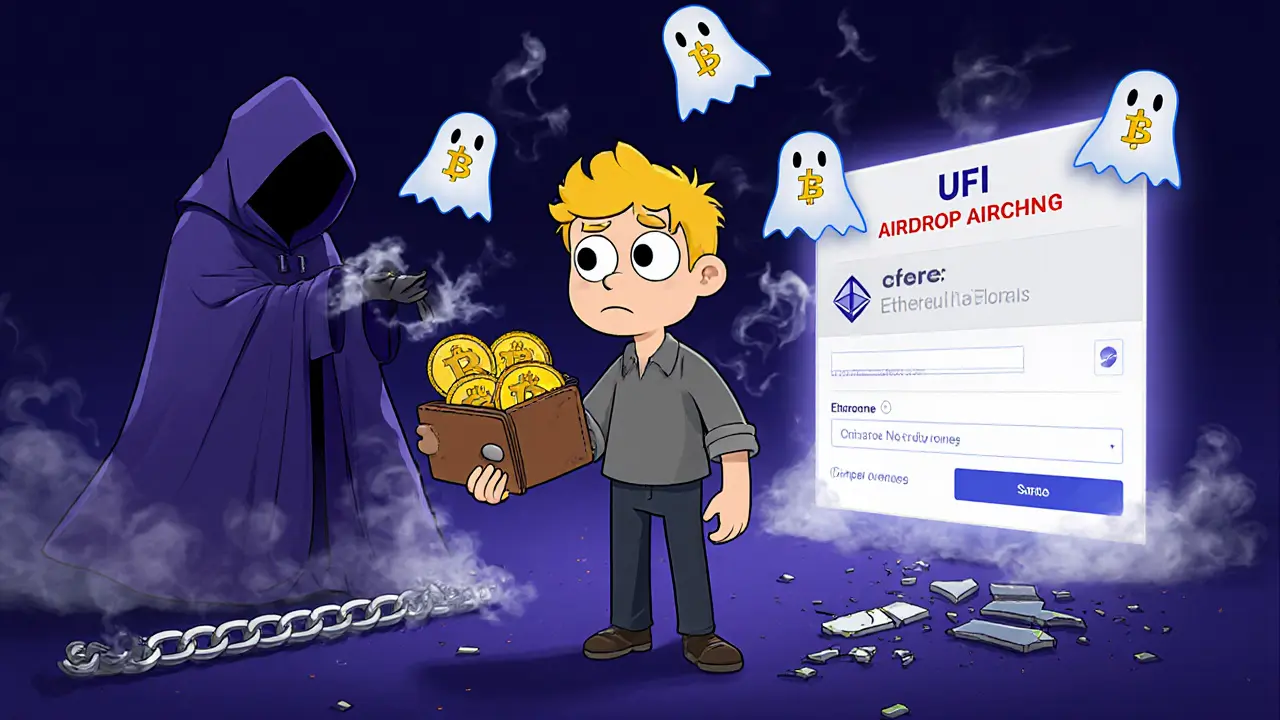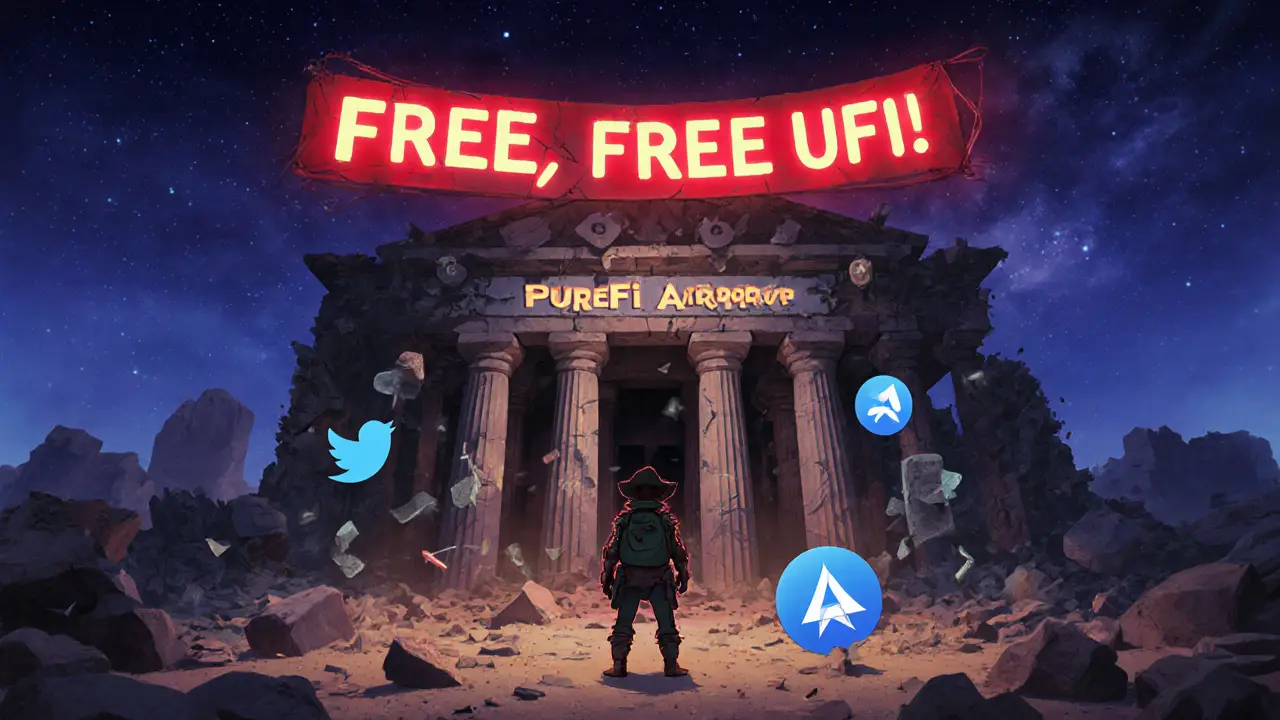There’s no official PureFi (UFI) airdrop running right now - not in any verified, active form. If you’re seeing ads, Telegram bots, or Twitter posts promising free UFI tokens, they’re almost certainly scams. The last confirmed UFI airdrop ended in early 2022, and since then, the project has gone quiet. The protocol hasn’t released new tokens, updated its airdrop page, or launched new campaigns. What’s left is confusion, broken links, and a community that’s tired of waiting.
What Is PureFi Protocol (UFI)?
PureFi Protocol is a DeFi project built to bring compliance tools - like KYC and AML checks - into decentralized finance. Unlike most crypto projects that prioritize anonymity, PureFi uses zero-knowledge proofs to let users prove they’re compliant without revealing personal data. It launched in mid-2021 with a $1.07 million funding round and a total token supply of 1 billion UFI. But here’s the catch: only 4.9 billion UFI are in circulation, which means the math doesn’t add up unless there’s a major error in reporting or a hidden minting mechanism.
The token was distributed across private sales, IDOs, and early community efforts. Roughly 20% went to the team and advisors, with vesting schedules stretching over five to ten months. Another 7% was set aside for marketing - which, by industry standards, should have funded airdrops. But those funds never materialized into public campaigns.
How Did PureFi Airdrops Work in the Past?
Between August 2021 and March 2022, PureFi ran three small airdrop campaigns. They weren’t big, but they were real. Here’s what you had to do back then:
- Follow their official Twitter account (@Purefi_Protocol)
- Join their Telegram group
- Complete a short quiz about the protocol’s compliance model
- Refer one or two friends to join
Participants who finished all steps received between 25 and 100 UFI tokens. That’s about $0.15 to $0.60 at today’s price ($0.00695 as of October 2023). Back then, UFI traded between $0.015 and $0.025, so those rewards were worth $0.38 to $1.50 - not life-changing, but enough to get some early users excited.
These airdrops were distributed via smart contracts on Ethereum and Binance Smart Chain. You could track the transactions on Etherscan. No KYC was required. No wallet deposits. No private keys handed over. Just simple social tasks.
Why Did the Airdrops Stop?
PureFi’s airdrop program died for three reasons: low demand, poor communication, and a collapsing token price.
First, the token never gained traction. It’s only listed on two decentralized exchanges - Uniswap and PancakeSwap - and daily trading volume has hovered below $5,000 for over a year. In Q3 2023, it was at $0. No liquidity means no interest. No interest means no reason to run airdrops.
Second, communication was a mess. Their official airdrop page (purefi.io/airdrop) redirects to the homepage. Their Twitter hasn’t posted about airdrops since October 2023 - just vague mentions of “upcoming community rewards.” GitHub commits stopped in April 2022. No new code. No new contracts. No updates.
Third, the price crashed. UFI peaked at $0.045 in June 2023. By October, it was down to $0.00695. That’s an 85% drop. When your token loses value, you don’t give more away - you hold on. The team likely shifted focus to survival, not growth.

Is There a PureFi Airdrop in 2025?
No. Not officially. Not even close.
Some crypto blogs still list PureFi as an “upcoming airdrop” - but they’re recycling old 2021-2022 content. No new announcements. No new smart contracts. No new participation rules. The protocol’s treasury is too small to fund anything meaningful. With a market cap under $800,000 and only two active GitHub contributors, there’s no financial or technical capacity for a new campaign.
There’s one sliver of hope: PureFi partnered with a European fintech firm, RegTech Solutions, in October 2023. They’re working on identity verification upgrades. If this leads to institutional adoption - think banks or regulated asset managers - they *might* launch a targeted airdrop for verified users in the EU. But that’s speculative. It’s not an airdrop for the public. It’s not even confirmed.
How to Spot a PureFi Airdrop Scam
Scammers love projects like PureFi. Low visibility. Low trust. Low activity. Perfect conditions for fraud.
Here’s how to tell if a PureFi airdrop is fake:
- Asks for your private key or seed phrase - Never, ever give this out. Real airdrops don’t need it.
- Requires you to send crypto first - “Pay a small fee to unlock your reward” is always a scam.
- Uses unofficial links - PureFi’s only official site is purefi.io. Any other domain is fake.
- Claims you’ve already won - “You’ve been selected for 10,000 UFI!” - That’s how they trick you into clicking phishing links.
- Uses fake Twitter accounts - Look for the blue check and verify the handle: @Purefi_Protocol. Anything else is impersonation.
Reddit users have reported dozens of scam airdrops since 2023. One user lost $470 after connecting their wallet to a fake “UFI claim portal.” Another spent two weeks completing fake Telegram quests - only to get zero tokens and a drained wallet.

What Should You Do Now?
If you’re waiting for a PureFi airdrop: stop. Save your time. Don’t risk your wallet.
If you already hold UFI: keep it in a secure wallet. Don’t trade it unless you’re prepared to lose most of its value. There’s no liquidity, no exchange listings, and no clear path to recovery.
If you want to participate in real airdrops: focus on projects with active development, clear tokenomics, and verified community engagement. Look at projects like Aave, Uniswap, or Arbitrum - they’ve run consistent, transparent airdrops for years. They don’t need to trick you. Their rewards are public, documented, and verifiable.
PureFi is a cautionary tale. It had a solid idea - compliance in DeFi - but failed to execute. No marketing budget. No community trust. No transparency. And now, no airdrop.
Alternatives to PureFi Airdrops
If you’re looking for real, active crypto airdrops in 2025, here are a few safer options:
- LayerZero - Ran a $25 million airdrop in 2023. Still active with cross-chain quests.
- zkSync - Rewards users for using its network. Recent airdrops went to early testers.
- Mode Network - New Ethereum L2 with ongoing user rewards.
- Base (Coinbase L2) - Regular airdrops for simple tasks like swapping tokens or bridging.
These projects have active teams, real usage, and public airdrop histories. You can check their official blogs or Twitter feeds for updates. No guesswork. No scams.
Final Verdict
PureFi (UFI) had potential. It didn’t deliver. The airdrop program is dead. Any current claims of free UFI tokens are scams. The protocol’s lack of development, low liquidity, and broken communication make it one of the riskiest projects in DeFi.
If you’re looking for crypto rewards, go where the activity is. Don’t chase ghosts. Don’t click on links from strangers. And never, ever give up your private keys.


Atheeth Akash
November 13, 2025 AT 01:11James Ragin
November 13, 2025 AT 05:31Michael Brooks
November 14, 2025 AT 14:22David Billesbach
November 16, 2025 AT 07:13Andy Purvis
November 16, 2025 AT 22:44FRANCIS JOHNSON
November 18, 2025 AT 22:15Ruby Gilmartin
November 20, 2025 AT 08:21Douglas Tofoli
November 21, 2025 AT 20:22William Moylan
November 22, 2025 AT 05:31Michael Faggard
November 22, 2025 AT 22:35Elizabeth Stavitzke
November 23, 2025 AT 14:02Ainsley Ross
November 25, 2025 AT 07:04Brian Gillespie
November 25, 2025 AT 19:52Wayne Dave Arceo
November 26, 2025 AT 23:39Joanne Lee
November 27, 2025 AT 13:43Laura Hall
November 27, 2025 AT 21:27Arthur Crone
November 28, 2025 AT 00:27